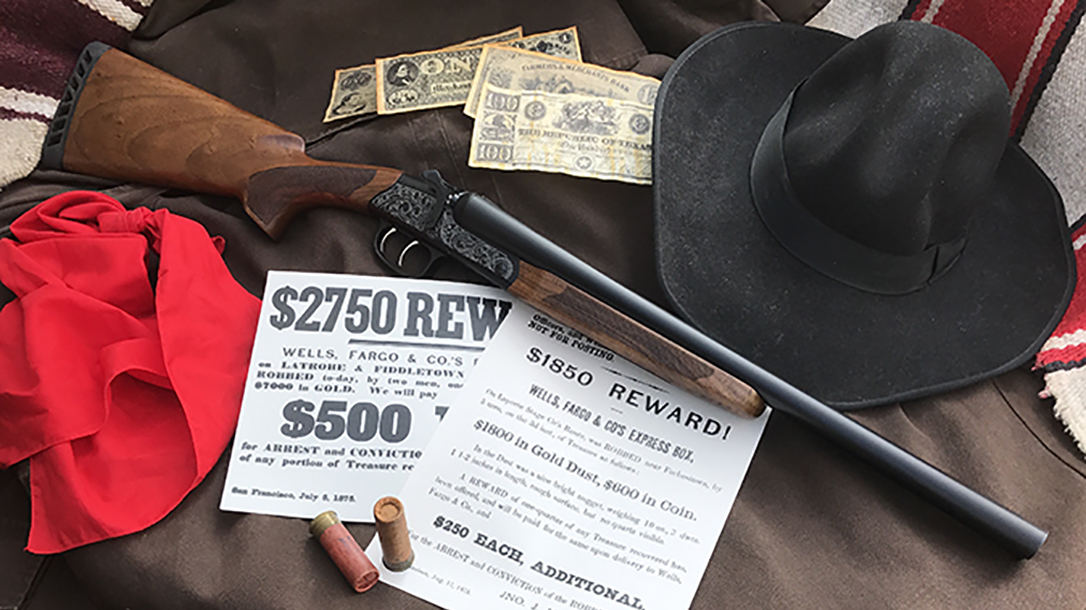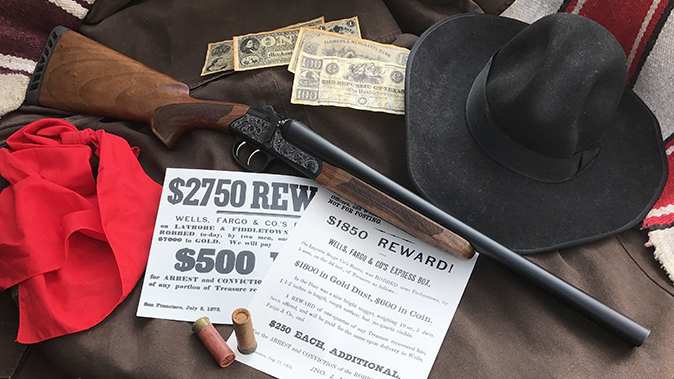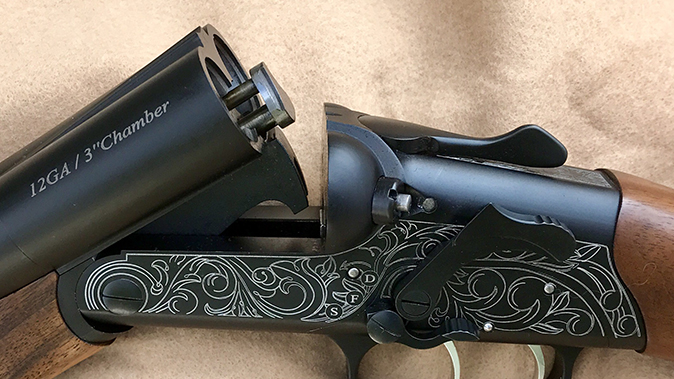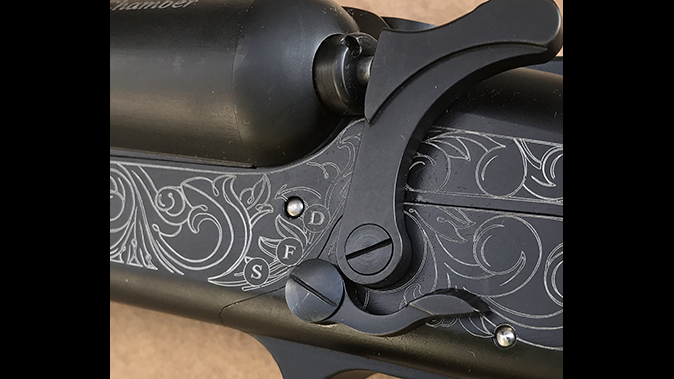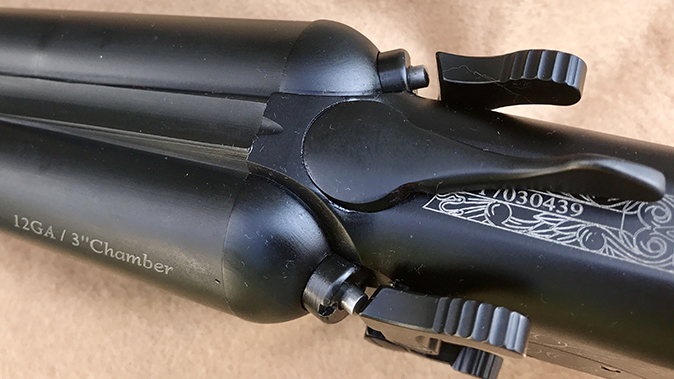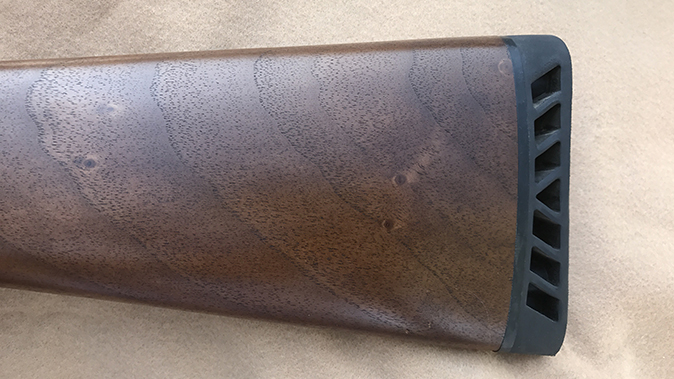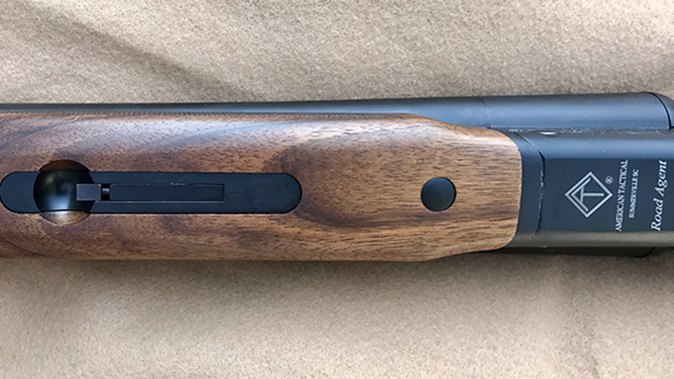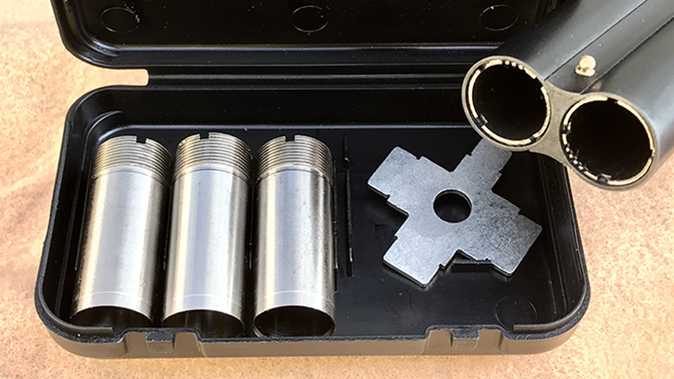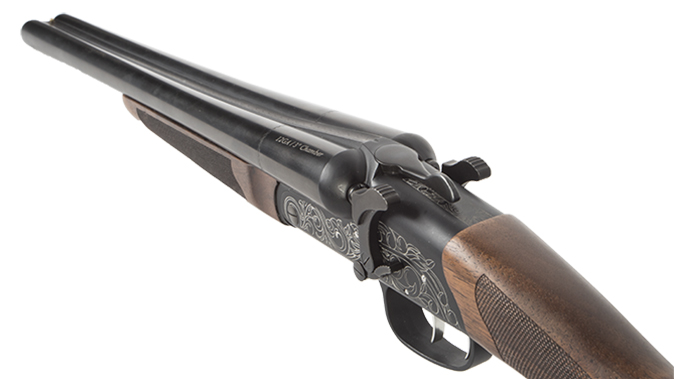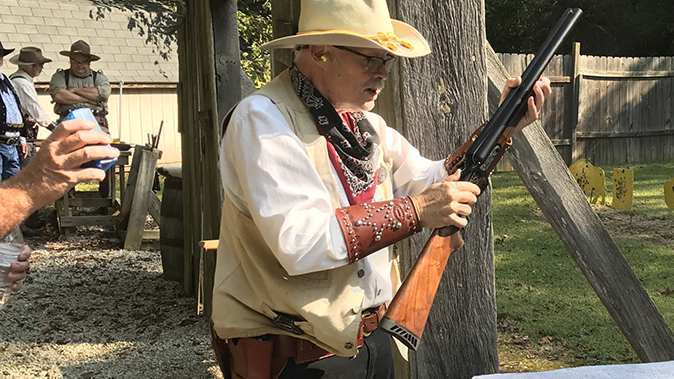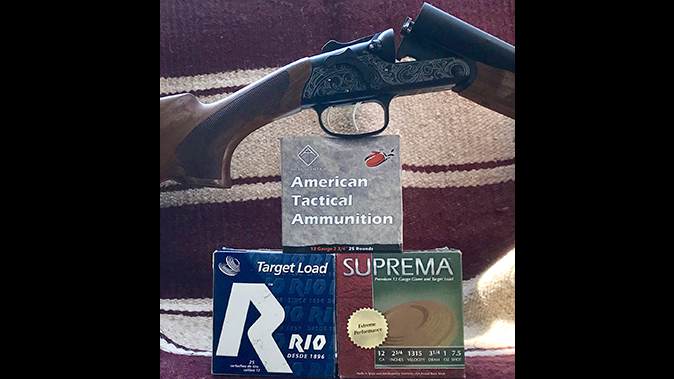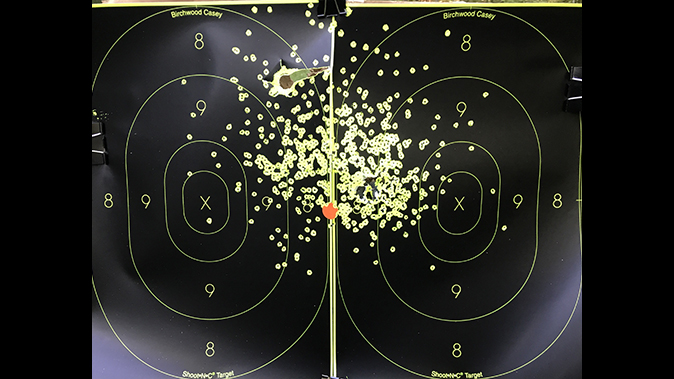One of the most useful and versatile guns in the Old West was the side-by-side double-barreled shotgun. It usually had a prominent place behind the front door of a pioneer’s cabin or “soddy,” putting meat on the table or keeping four- or two-legged predators at bay.
The double gun was also a favorite of stagecoach guards (riding shotgun) and express agents, plus peace officers of all kinds. Of course, outlaws took to it for the same reasons, and it helped in the robbery of many banks and stagecoaches or trains. Today, the side-by-side double gun is still popular with hunters and sees some defense use by homeowners, but it seems the biggest market for these guns is Cowboy Action Shooting (CAS).
I recently became aware of a side-by-side scattergun that appears to be tailor-made for CAS use: the American Tactical Road Agent. With that moniker and the image it projects, you can almost see a ghostly visage of Black Bart in the background pulling a holdup on a Wells Fargo stagecoach. Made in Turkey, this shotgun has a lot of features that modern-day “cowboys” will most likely appreciate.
Advertisement — Continue Reading Below
Agent Details
The American Tactical Road Agent is an expansion of AT’s Cavalry shotgun line, and my test gun came in a segmented cardboard box containing the barrels, receiver/buttstock and forend. Also in the box was a plastic container with three choke tubes and a wrench, a safety padlock and two sample packets of Extreme Duty Gun Oil from Lucas Oil Products. Of course, there was also a detailed owner’s manual that included warranty and product registration information. Looking at the choke tubes, I wondered how to tell them apart until I saw some little “dash” cuts on the muzzle end. Per the owner’s manual, five dashes meant cylinder bore, four stood for improved cylinder (both of which were already installed), then you had modified, improved modified and full chokes. They screw in and out using the supplied wrench.
Advertisement — Continue Reading Below
I gave all of the components a look-see, and everything appeared to be well made, with very good marks for fit and finish. The left barrel was laser-etched with the gauge and chamber size, and the two are held together with a solid rib that has a shallow U-shape. Rising upward from the breech, there is a small v-shaped notch for a rear sight where the rib meets the breechface of the receiver. The barrels are 18½ inches long and fitted with a brass bead front sight. The bluing has a non-reflective matte finish.
The American Tactical Road Agent has a regular extractor, with no ejectors per Single Action Shooting Society (SASS) requirements. At the breech, the chambers are chamfered for easy insertion of shotshells.
The receiver is a shade darker and is made of aluminum alloy, which helps keep the unloaded weight down to 5.3 pounds. It is a two-piece affair, with the larger portion having the barrel hinge, barrel locking mechanism and breech lever. I’ll refer to the smaller portion as the action/trigger assembly, and it is just that, plus the triggerguard. Laser-etched engraving is present on the sides and top of the receiver as well as the bottom of the triggerguard, which I could honestly do without.
Advertisement — Continue Reading Below
Old Look, Modern Tech
The really unique components here are the exposed hammers and the “Auto-Cock” action. You get the flavor of a “mule-eared” double gun with a modern technological advantage. When you break the action open to load or unload the gun, the exposed hammers are automatically put into the full-cocked position. As double guns must be staged open at CAS matches, all that is required is to pick up the open gun, load two shells, close the barrels and shoot. You don’t have to cock the hammers manually, and there’s no automatic safety to remember to take off.
Adding to this, a decocker lever can be found on the left side of the receiver, just below the hammer. It has three positions, with a small pointer indicating what position it is in. This corresponds with three small letters etched into the receiver just ahead of the lever. The first is “S” for safety, and this locks the triggers with the hammers cocked. Next is “F” for fire, and is “D” for decock. When the lever moves to the latter position, both hammers safely drop without striking the firing pins. The double triggers themselves have a silver finish. The front trigger is for the right barrel, and the rear fires the left barrel.
Advertisement — Continue Reading Below
Hand-finished and fitted Turkish walnut is used for the buttstock and forend. My test gun had pretty decent figuring and attractive little “bird’s eyes” in the wood. I’m going to guess that the checkering on the pistol grip of the buttstock and the forend is done by machine; it is very fine and intricate. There’s also a ventilated recoil pad that is textured at the rear so as not to slip on the shoulder. The length of pull from the front and rear triggers is 15½ and 14¾ inches, respectively. The drop at the heel is 2¼ inches while the drop at the comb is 1¾ inches.
A large takedown latch is located on the underside of the forend, expertly inletted into the wood with a round indentation to access the release lever. The wood-to-metal fit shows the wood just slightly oversized where it meets the receiver, but I won’t shave off many points for that.
When I first picked up the shipping box, I noted that it was a bit heavy. A second look revealed three boxes of 12-gauge shotshells from AT, also produced in Turkey. There were 25 rounds in each box—what we would term “low brass” with a three-dram equivalent powder charge and one ounce of #7½ shot. These are 2¾-inch shells with red plastic hulls and natural brass bases. They are nicely rounded on the sides of the crimp so as to make chambering a bit easier. As low-brass #7½ shotshells are perfect for CAS use, I decided to use these at the next SASS match I attended.
Advertisement — Continue Reading Below
I thought it prudent to pattern the American Tactical Road Agent to see how it would do at the range or in the field before I actually went to a match. While holes in the pattern won’t matter much for CAS use, I did want to make sure the shot column matched up with where I put the bead front sight.
Even though I planned to use the AT-supplied shells at the CAS match, I was curious to see what some other brands of 2¾-inch shells would do. I selected a box of Spanish-made Suprema Game & Target shells from TulAmmo, a 3.25-dram load with 1 ounce of #7½ shot, low-brass and red plastic hulls. I also chose another load from Spain: Rio’s low-brass, 2.75-dram Target shells filled with 1.12 ounces of #7½ shot and contained in blue plastic hulls. For targets, I decided to use Shoot-N-C B-27 silhouette centers from Birchwood Casey. They are about the size of many of the falling steel shotgun targets at SASS matches and show patterns well.
I figured that 10 yards was about the average distance for shotgun targets at SASS matches, so I used that as my patterning range. I put two of the B-27 targets side by side on my target stand, with a red dot in the center for an aiming point. Shooting the AT shells first, I noted two things: This lightweight scattergun kicks a bit, and the shot was going just a tad higher than my point of aim. The right barrel went slightly right of center, and the left barrel went slightly left, and it pretty much stayed that way with the Rio and Suprema shells, too.
Advertisement — Continue Reading Below
The AT shells had the tightest pattern for two shots. You have to remember that this gun has short 18½-inch barrels, plus the chokes were cylinder and improved cylinder, so open was the order of the day. The Rio loads patterned just a bit larger, and the Suprema shells opened up a bit coming out the left barrel. I really wasn’t concerned about the point of aim/point of impact, as it wasn’t enough to make a big difference on falling steel targets. The patterns were fairly uniform, with no gaping holes between the impacts on the targets.
Match Time
Advertisement — Continue Reading Below
To really see how the American Tactical Road Agent would run, it took it to an SASS match. I used the AT #7½ shells, carrying them in a six-shell slide on my gun belt. I also decided to use two .45 Colt sixguns and a Model 1892 lever-action reproduction in .357 Magnum. We had fantastic weather for an early September day in Southern Indiana, which didn’t hurt anybody’s shooting one bit.
I signed up to shoot in the Senior category and, as usual, just shot against myself with the fervent hope for a clean match with no misses or errors. There were 26 shotgun targets spread across six main match stages, and I did not record a single miss. In SASS, if you miss a shotgun target, you shoot until it falls. One bobble I did have was with the decocker lever on the American Tactical Road Agent. It has to be fully in the “fire” notch if you want it to go off. I’d been showing the gun around to my compadres and neglected to check the lever—I was surprised when I pulled the front trigger and the right-side hammer didn’t fall.
Except for that single “Oh, Hades!” moment, the American Tactical Road Agent did just fine. It was fast to load with the hammers pre-cocked. When firing on four to six targets in a stage, the Auto-Cock feature seemed to make things even quicker and easier. Empty shells fell right out of the chambers without the little flip I normally give the shotgun once I’ve broken it open to help the spent hulls fly out. The front bead was fast to find. Even though it’s short, the shotgun swung smoothly from target to target. The recoil pad did a laudable job, and that fine checkering on the stock prevented any slippage during fast handling.
Advertisement — Continue Reading Below
On the whole, the American Tactical Road Agent impressed and believe it is a solid value for the price. I’d like to see a matte silver or natural aluminum finish on the receiver in place of the engraving, but that’s all I’d change.
American Tactical Road Agent Specs
| Gauge: 12; 3-inch chambers |
| Barrel: 18.5 inches |
| OA Length: 35.5 inches |
| Weight: 5.3 pounds (empty) |
| Stock: Turkish walnut |
| Sights: Bead front, notch rear |
| Action: Break |
| Finish: Blued, anodized |
| Capacity: 2 |
| MSRP: $600 |
American Tactical Road Agent Performance
| Shotshells | Velocity | Pattern |
|---|---|---|
| American Tactical 1-ounce #7½ | 1,235 | 13.54 |
| Rio 1.12-ounce #7½ Target | 1,150 | 14.21 |
| Suprema 1-ounce #7½ Game & Target | 1,315 | 15.78 |
*Velocity in fps per MFG specifications and pattern in inches for two shots at 10 yards with cylinder and improved cylinder chokes.
